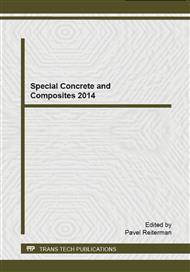[1]
G.M. Bruere. Bleeding of cement pastes containing paraffin wax emulsions and clays. Cement and Concrete Research, 4(4): 557 - 566, (1974).
DOI: 10.1016/0008-8846(74)90006-4
Google Scholar
[2]
C.B. Geishauser and P.D. Cady. A study of the heat treating cycle for internally sealed concrete containing montan-paraffin wax beads. Cement and Concrete Research, 7(1): 85 - 93, (1977).
DOI: 10.1016/0008-8846(77)90012-6
Google Scholar
[3]
Q. Wang, J. Zhang, Z. Ding, and L. Qiu. Study on properties of paraffin phase change energy storage concrete. Energy Procedia, 16, Part A(0): 365 - 370, 2012. 2012 International Conference on Future Energy, Environment, and Materials.
DOI: 10.1016/j.egypro.2012.01.060
Google Scholar
[4]
X. Li, J.G. Sanjayan, and J.L. Wilson. Fabrication and stability of form-stable diatomite/paraffin phase change material composites. Energy and Buildings, 76(0): 284 - 294, (2014).
DOI: 10.1016/j.enbuild.2014.02.082
Google Scholar
[5]
T. -C. Ling and C. -S. Poon. Use of phase change materials for thermal energy storage in concrete: An overview. Construction and Building Materials, 46(0): 55 - 62, (2013).
DOI: 10.1016/j.conbuildmat.2013.04.031
Google Scholar
[6]
K. Pielichowska and K. Pielichowski. Phase change materials for thermal energy storage. Progress in Materials Science, 65(0): 67 - 123, (2014).
DOI: 10.1016/j.pmatsci.2014.03.005
Google Scholar
[7]
PN-EN 197-1: 2012. Cement. Composition, specifications and conformity criteria for common cements, (2012).
Google Scholar
[8]
PN-EN 12350-5: 2011. Testing fresh concrete - Part 5: Flow table test, (2011).
Google Scholar
[9]
PN-EN 12390-3: 2011/AC: 2012. Testing hardened concrete - Part 3: Compressive strength of test specimens, (2012).
Google Scholar
[10]
PN-EN 12390-6: 2011. Testing hardened concrete - Part 6: Tensile splitting strength of test specimens, (2011).
DOI: 10.3403/30200045
Google Scholar
[11]
J.J. Chen, A.K.H. Kwan, and Y. Jiang. Adding limestone fines as cement paste replacement to reduce water permeability and sorptivity of concrete. Construction and Building Materials, 56: 87 - 93, (2014).
DOI: 10.1016/j.conbuildmat.2014.01.066
Google Scholar
[12]
W. Kubissa and R. Jaskulski. Measuring and time variability of the sorptivity of concrete. Procedia Engineering, 57(57/2013): 634 - 641, (2013).
DOI: 10.1016/j.proeng.2013.04.080
Google Scholar
[13]
W. Kubissa, I. Wilińska, and M. Pałuba. Badanie właściwości betonów cementowych wykonanych z udziałem odpadów przemysłowych. Przegląd Budowlany, 84: 35 - 39, (2013).
Google Scholar
[14]
C. Tasdemir. Combined effects of mineral admixtures and curing conditions on the sorptivity coefficient of concrete. Cement and Concrete Research, 33(10): 1637 - 1642, (2003).
DOI: 10.1016/s0008-8846(03)00112-1
Google Scholar
[15]
R.J. Gummerson, C. Hall, and W.D. Hoff. Water movement in porous building materials - II. hydraulic suction and sorptivity of brick and other masonry materials. Building and Environment, 15(2): 101 - 108, (1980).
DOI: 10.1016/0360-1323(80)90015-3
Google Scholar
[16]
C. Hall. Water sorptivity of mortars and concretes. Magazine of Concrete Research, 41(147): 51 - 61, (1989).
DOI: 10.1680/macr.1989.41.147.51
Google Scholar


